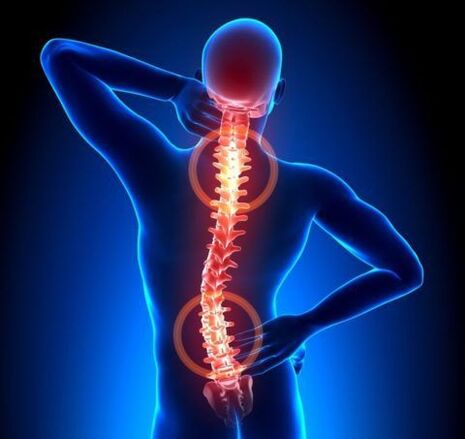
Many people between the ages of 30-35 complain of back pain.The cause of these pain may be spinal disease.Osteochondrosis is a disease that occurs in average people, but is more commonly detected in patients after 40 years.
Osteochondrosis - What is this disease and what is its danger?
This term means a dystrophic process of cartilage and bone tissue subject.In modern medical practice, osteochondrosis is called degenerative-dystrophic disease of the spine and intervertebral discs that play the role of the shock absorber.The danger of the disease is that the affected disc is almost impossible to recover and without proper treatment is possible to damage.
Is osteochondrosis a common disease?Statistics are not happy.About 85% of the world's population suffers from this disease.
This disease is the most common form among all diseases that affect the spine.And according to the spread, it is immediately after diseases of the cardiovascular system.
The essence of the disease
So, osteochondrosis - what is it?It is a chronic disease that affects the joints, most often the spine.
The spine consists of 24 vertebrae.Between the two vertebrae is a disc, the purpose of which is the softening and depreciation of the load.
In the normal state, the disc is quite elastic and can withstand considerable loads.In the center of the disk there is a pulp core with lots of water.For some reason, the nucleus loses its hydrophilic properties.
As a result, the disc is delayed, reducing height and deformation.In the short stages, bone tissue growth occurs with the formation of outgrowths - osteophytes that compress the peripheral nerves and spinal cord.This is osteochondrosis of the spine.
The reasons for the pathology
Despite the fact that osteochondrosis is a very common disease, the causes of the pathology are not fully established.
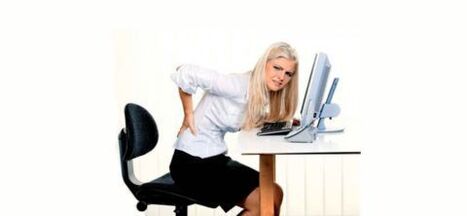
The main factors are considered:
- excessive spinal load;
- Injuries;
- Professional harm - lifting weights or prolonged work in an uncomfortable, stationary posture;
- excess body weight;
- heredity;
- Stand violation.
Osteochondrosis develops to one degree or another in almost all people of the elderly and is one of the processes of aging of the body.
Stages, forms and symptoms of the development of the disease
Experts distinguish 4 stages of the disease:
- 1st stage- moving the core of the disc to the edge;
- Stage 2- the appearance of cracks in the wheels of the cartilage and the instability of the vertebrae;
- Stage 3- complete rupture of the disc with the loss of the nucleus in the stem of the spine, while the roots of the spinal cord are possible;
- Stage 4- Rough changes not only in the intervertebral disc, but also in the surrounding tissues.
The main symptom of the disease is pain.It can be acute with high intensity or dull, moderate manifestation.
In addition to the pain there is:
- painful tension of the posterior muscles;
- numbness of the skin of the hands and feet;
- limiting the volume of movements;
- weakness in the muscles of the limbs;
- thinning of the arms and legs;
- Suddenly dizziness.
These are common manifestations for all forms of pathology.Depending on the spine in which the changes are localized, three forms of the disease with characteristic symptoms are distinguished.
Table # 1. Forms of osteochondrosis and their inherent symptoms:
| Disease | Symptoms |
| Osteochondrosis in the neck | Changes in this department lead to the pressure of blood vessels and impaired microcirculation.For this reason, one has constant dizziness.Sometimes this leads to seizures.There is noise and flicker in the ears of colored spots in front of the eyes. |
| Osteochondrosis in the thoracic vertebrae | In this form of the disease, acute chest pain is observed.The disease can cause the progression of intercostal neuralgia and worsen the course of cardiac pathologies. |
| Osteochondrosis in the lumbar region | The pathology in the lower back is manifested by pain in the gluteal region, reducing the tone of IKR.A complication may be radiculitis, which is accompanied by pain spread in the legs. |
Due to the pathology of the spinal discs there are a large number of disorders in the body: pinching of nerves, swelling, disorder of blood circulation and fibrosis of the surrounding tissues.These changes cause different symptoms, which complicates the diagnosis and prescribes appropriate treatment without careful examination.
Clinical manifestations
The symptoms of the disease depend on where the lesion is mainly located.In the sections below, we look at the signs characteristic of every variety of the disease.
Cervical department
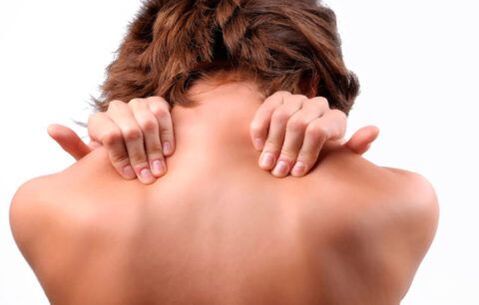
The main symptoms of damage to the cervical spine include:
- discomfort, neck and shoulder tenderness;
- muscle hypotonus;
- increased sweating;
- Tingling of the fingers;
- violation of movement coordination;
- headache, dizziness;
- Hearing and vision problems;
- Hypertension.
With the progression of the disease and damage to the nearby arteries and nerves, one of the following syndromes can develop:
- spinal artery;
- cardiac;
- hypertension;
- root;
- Cervical migraines.
Disruption of blood circulation in the spinal artery and this hypoxia of the brain tissues are the dangerous effects of osteochondrosis.
This syndrome manifests itself:
- system/periodic dizziness;
- Weight loss of vision;
- partial or complete hearing loss;
- Sometimes a seizure.
Important!The neurological manifestations of osteochondrosis of the spine should often differ in brain atherosclerosis, DEP and other pathologies.
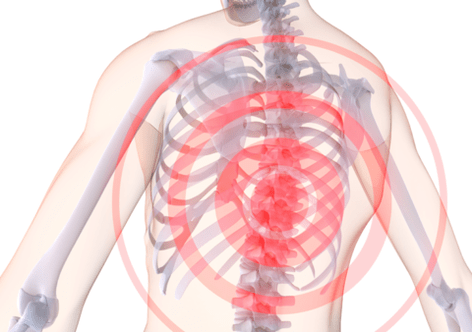
Thorax
Compared to other forms of the disease, thoracic osteochondrosis manifests itself more pronounced.
Among his symptoms:
- chest pain, increasing at night or with prolonged in one position;
- discomfort, feeling of squeezing between shoulder blades;
- Strengthening the pain during deep breathing.
If the disease is not treated, it will progress, causing damage to the relatives and nerves located nearby.
Signs of the development of complications of osteochondrosis of the spine of this localization may be:
- Tingling of the skin in some areas, a feeling of creeping of Guzebumps;
- Itching of the skin, burning;
- limb cooling;
- nail fragility;
- pronounced dry skin;
- pain along the esophagus and pharynx;
- Disorders of the gastrointestinal tract.
In addition, the location of the breast of the disease is characterized by two specific symptoms - Dorsago and Dorsalgia.
Dorsago is a sudden, acute and very intense chest pain, "chest shift".It can occur with prolonged in the same position, monotonous work.
Pay attention!During breast milk, the pain is so intense that patients are afraid to even take additional inhalation.
Dorsalgia is less intense, but monotonous painful sensations that can last for up to 2-3 weeks.They are enhanced by deep breathing, inclinations.
Lumbar department
Osteochondrosis of the lower spine, namely the lumbar, occupies a leading position for distribution.

Among its characteristic symptoms:
- Dumb, more sick pain in the lower back, radiant in the legs;
- discomfort that enhances the body position, sneezing, coughing, attempt to lift weights;
- constant muscle spasm in the lower back;
- Lower lights;
- Impaired sensitivity on the skin of the ass, hips, legs, legs;
- feeling of crawling thick on the lower limbs;
- Dry, skin peeling.
The sacral department
Osteochondrosis of the sacral spine is extremely rare in an isolated manner and is usually a "continuation" of the lower lumbar damage.
This explains the characteristics of its symptoms:
- Lower back pain as well as in the sealing nerve;
- Sharp "shelters" throughout the leg;
- an unpleasant feeling of discomfort in the back of the thigh;
- numbness of the lower limb;
- Paresis, as well as unstable symptoms of impaired motor activity.
Important!Osteochondrosis of the lower spine can lead to such extremely dangerous complications as impaired blood supply to the spinal cord and compression myelopathy.
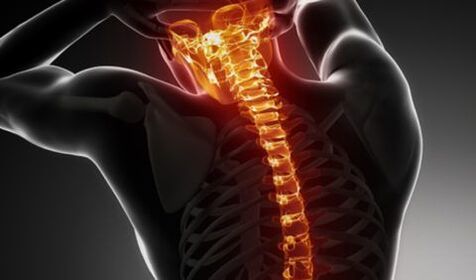
Common osteochondrosis
General form or osteochondrosis of all parts of the spine is the most severe version of the pathology.Due to the vastness of the lesion, its picture can be extremely diverse and include almost all the symptoms described above.
Diagnostic methods
The appearance of any complaints indicated above requires an appeal to a medical institution: the patient should examine the patient.The diagnosis of osteochondrosis should be complex and very thorough.
The standard instruction includes the following stages:
- Collecting complaints and history.
- Clinical examination.
- X -Rev review.
- Modern methods (CT, MRI).
Talking to the patient, the doctor should understand:
- which bothers the patient;
- What is the place of the most pronounced unpleasant sensations;
- What is their intensity and duration;
- which provokes their strengthening;
- Which helps to deal with the pain.
Important!Be sure to tell the doctor how long you have been concerned about such complaints and whether you have received any treatment earlier.
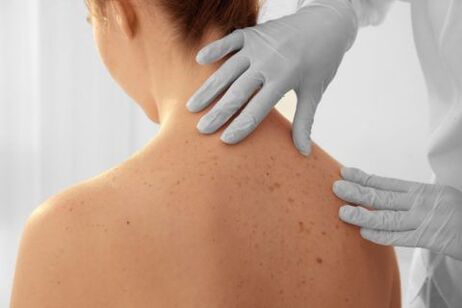
During a clinical examination, the specialist evaluates:
- the position of the patient's body, his gait, the volume of active and passive movements;
- The presence of skin defects, redness, peeling;
- Symmetry of healthy and diseased parts of the body;
- The presence of muscle spasm;
- the area of pain irradiation;
- The presence of pain, fever and other types of sensitivity.
During radiography, each spine for better visualization is studied individually.The photos are taken in direct, lateral and (according to indications) of two inclined projections.To evaluate the stage and severity of degenerative dystrophic changes, the X -ray classification of the osteochondrosis of the spine of the cycle is used.
Table: X -rainy stages of osteochondrosis of the spine:
| Stage | Description |
| I (+) | Unsurved changes in lordosis in a small number of segments |
| II (++) |
|
| III (+++) | Expressed changes, a significant narrowing of the intervertebral holes |
| IV (++++) | Significant narrowing of intervertebral holes, massive exostosis, often irreversible changes |
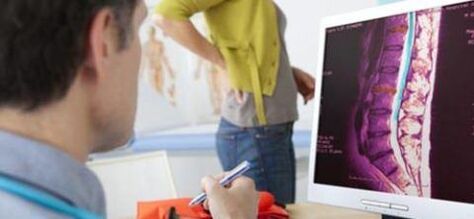
With insufficient information content of the patient's R-card, more modern CT tests may be prescribed (directional images of one or more segments of the spine) and MRI (visual diagnostic method based on the properties of electromagnetic radiation).
Treatment
First, the doctor explains to the patient what osteochondrosis is and how to treat it.He talks about a set of measures that must be taken for a long period.
The treatment of the disease is performed taking into account the stage.In the initial period of the disease, massage, physiotherapy, physiotherapy exercises are shown.But as the dystrophic process progresses, various orthopedic devices to immobilize the spine must be used.Drug treatment is also required.
Surgical intervention is shown with complications and the ineffectiveness of conservative treatment.
Medication
The most important tasks of treatment with pharmacological drugs are relieving pain, eliminating inflammation of the nerve roots, restoring the structure of cartilage, improving blood circulation and nutrition, stopping the development of pathology.In this case, there are several groups of medicines that can be prescribed.
In pharmacies, they are represented in various forms and in great variety.The cost of medicines can be different and you can always choose the most accessible.
Table # 2. Medicines used in conservative osteochondrosis therapy:
| Pharmacological group | Therapeutic effect | Instructions for use |
| Chondroprotectors | Delay the cartilage degeneration processes, contributes to its restoration. | Take 1 capsule per month.If necessary, the course of treatment is repeated. |
| Nsaid | It has an anesthetic effect, reduces the inflammatory process. | Take a pain tablet.In severe pain, intramuscular injections of the drug are used. |
| A group of groups | Improves nerve impulse conductivity, restores microcirculation in the area of the affected cartilage. | A course of treatment with intramuscular injections is carried out. |
| Monsolelaxants | It relaxes the muscles, relieves tension, facilitates pain. | Take one tablet 2 times a day. |
Medicines are prescribed according to the doctor's testimony.Suicide can be ineffective, and in some cases even harms.
Physiotherapy for osteochondrosis
What to do with osteochondrosis, except for medicines, to accelerate recovery?One of the most effective methods of treating this disease is physiotherapy.
Its advantage is a selective effect on the focus of the disease.Contribution of physiotherapy to reduce pain, eliminating inflammation and increased overall immunity.With their help, the muscles relax, metabolic processes and blood circulation are normalized.
For osteochondrosis, they are successfully used:
- magnetotherapy;
- laser therapy;
- shock wave therapy;
- quartz;
- electrophoresis;
- The effect of low frequency electrical currents.
Physiotherapy does not occur if the patient is in a serious condition, with exacerbation of the disease, cancer and mental disorders.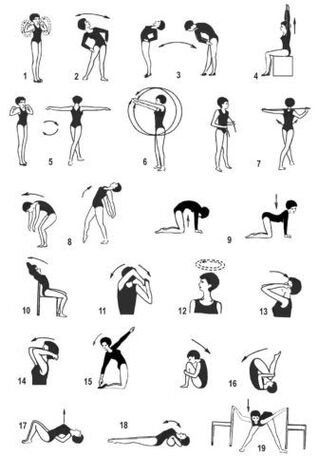 In other cases, physiotherapy has a beneficial effect on the recovery process, enhances the effect of drugs, which reduces their dose.
In other cases, physiotherapy has a beneficial effect on the recovery process, enhances the effect of drugs, which reduces their dose.
Medical physical education
Physical education classes are prohibited in the acute period of the disease.After eliminating this period, the doctor prescribes therapeutic exercises that he or she develops together with the instructor separately for each patient.
With the help of exercises, the muscle corset is enhanced, which prevents the spinal curvature and allows you to properly and evenly distribute the load on the vertebrae.With regular exercise, the healing substances penetrate the spine at higher concentrations than in their absence.
It is necessary to join the manual of an experienced instructor and carefully monitor their condition.With discomfort and severe pain, the exercise should be stopped.
Prevention
Knowing what osteochondrosis is and its consequences will be useful to think about prevention.
Preventive measures are quite simple, they are easy to implement everyone who is interested in their health:
- Prevention of injuries;
- Regular physical fitness (swimming is very useful);
- Maintain normal weight;
- Do not charge the spine;
- Monitor the correctness of the stand;
- not be in one position for a long time;
- Avoid sudden movements when lifting weights.
When you implement these rules, the remission period will be long.
Osteochondrosis is a very serious disease.But with the timely search for a doctor and adequate treatment, it is possible to stop his destructive effect.
Questions to the doctor
Neck pain
Hello, tell me please.I'm 24 years old.For the last few months, neck pain, back of the head (sometimes still giving whiskey, eyes).I also notice a strong crunch in the neck, numbness and tingling of the arms, tongue and the sky.
I suspect osteochondrosis because both mom and grandmother of youth are tormented by similar symptoms.Where to start the exam?And another question: can I go to aerobics?
Make a R-Scheme (CT) store and Doppler on the vessels of the head and neck.You may have developed spinal artery syndrome against cervical osteochondrosis.Another plan for diagnosis and treatment can only be drawn up after receiving the results of these tests.
It is better not to visit aerobics more.
Lumbar osteochondrosis
For seven years I have been tormented by the lower back, the exacerbation of osteochondrosis is almost every 2-3 months.Injections and tablets help briefly, and then the pain returns.I work as a postman, it gets more difficult.Do I put damage?
Hi!The decision to award the group for people with disabilities is made by ITU based on a comprehensive study of your situation.First you need to contact the therapist and take the exam.
As a rule, with lumbar osteochondrosis, the disability group is not displayed.His award is possible with the development of complications (bulges, intervertebral hernias, etc.).But, again, I repeat, everything is individual here.

























